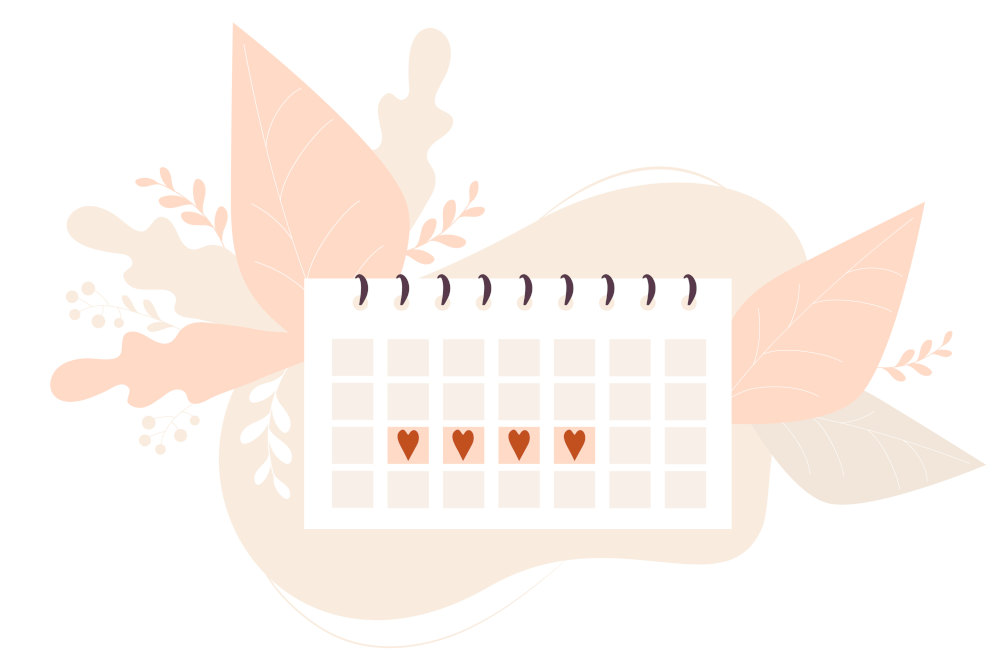If you’re on the hunt for a non-hormonal birth control option, you may have seen the rhythm method come up in your search. The rhythm method is an age-old form of natural family planning that relies on tracking your menstrual cycle to predict when you’ll ovulate (1,2). Learn more about the rhythm method of birth control, how it works, its effectiveness, and if it’s right for you.
What is the rhythm method?
The rhythm method, often referred to as “the calendar method,” is a natural family planning strategy in which a person relies on tracking their menstrual cycle to determine when they’re most fertile (3). Couples trying to get pregnant can use the rhythm method to figure out the best, most fertile days to have sex. Those who want to avoid pregnancy can use the rhythm method to determine which days they should abstain from sex or use a barrier method of contraception (2, 3).
How does it work?
The rhythm method works by tracking your cycle and getting a better understanding of when you’re fertile (aka able to get pregnant) (2).
Typically, a person’s menstrual cycle is between 21 and 35 days long. (This can vary from person to person, based on age, BMI, lifestyle, and diet). There are approximately six days during your cycle in which you can get pregnant — this time frame is known as your fertile window.
An egg can live for 24 hours after it’s released from your ovaries. Sperm, however, can live in the reproductive tract for up to three to five days (3). This means, that if you’re using the rhythm method as a form of birth control, you’ll need to avoid sex or use a condom or other form of barrier contraceptive up to five days before ovulation and 24 hours after ovulation.
How to use the rhythm method of birth control
To use the rhythm method effectively as a form of birth control, you’ll need to track your menstrual cycle for at least six months. This way, you can accurately predict when you ovulate. According to OB GYN and fertility specialist, Dr. Hrishikesh Dattatraya Pai, there are a few different ways to do this, including charting your basal body temperature (BBT), monitoring changes in your cervical mucus, and tracking changes in your cervix.
1. Chart your basal body temperature (BBT). Your basal body temperature (BBT) is your body temperature first thing in the morning before you get out of bed. During ovulation, your temperature rises approximately 0.5 to 1 degrees Fahrenheit (6). To chart your BBT, check your temperature (you can use a BBT thermometer or a regular thermometer) each morning and write it down. If you choose to use the BBT method, be sure to take your temperature at the same time every day as it could fluctuate.
2. Monitor changes in your cervical mucus. Another way to predict ovulation is to monitor your cervical mucus or vaginal discharge. Before ovulation, your cervical mucus becomes clear and slippery (kind of like raw egg whites). To track changes in your vaginal discharge, keep a journal and write out the changes you see in color and texture each day. According to Planned Parenthood, using the BBT method in combination with the cervical mucus method (together they’re referred to as the symptothermal method) is more effective than using one or the other on its own.
3. Track changes in your cervix. Tracking changes in your cervix can also give you an idea as to when you’re ovulating. Before ovulation your cervix becomes soft, high, open, and wet — the acronym SHOW can help you remember this. To check your cervix, wash your hands and find a comfortable position in which you can easily reach your cervix (e.g. squatting, standing with one leg lifted on the edge of a bathtub or chair, sitting on the toilet, etc.). Insert your middle finger into your vagina until you’re able to feel your cervix. Take notes on the position, how it feels, whether it’s angled to the side or centered, and whether it’s slightly open or closed. The best time to check your cervix is after a shower or bath (8).
You can also:
4. Keep a menstrual diary: If you’re looking for a less invasive way to track your ovulation, you may want to consider keeping a menstrual diary to keep tabs on when your period comes each month. You can also use an online period or ovulation tracker. Some options include: Flo, Ovia, Clue, and Natural Cycles. Both Clue Birth Control and Natural Cycles Birth Control are considered an effective form of contraceptive by the FDA.
5. Use an ovulation predictor kit: You can purchase an ovulation predictor kit from your local drugstore or Amazon for $10–$49. These kits work by measuring your luteinizing hormone (LH) levels and all you have to do is pee on a stick. That said, the American College of Obstetricians and Gynecologists (ACOG) doesn’t recommend tracking ovulation as a sole method of birth control.
“Once you've been tracking your menstrual cycle for a few months, you should start to see a pattern emerging,” says Dr. Hrishikesh Dattatraya Pai. “This will allow you to predict when you're going to ovulate and plan accordingly. If you want to avoid pregnancy, you should either abstain from sex or use a barrier method of contraception during the days leading up to and including ovulation.”
How effective is the rhythm method?
While its effectiveness ultimately depends on the combination of tracking methods used and how regular a person’s cycle is, with perfect use, the rhythm method has a failure rate of less than 5%. Using Clue Birth Control and Natural Cycles Birth Control are FDA-approved methods of birth control. In 2021, Clue told TechCrunch that their birth control tracking app “has been shown to be 92% effective at preventing unwanted pregnancy under ‘typical use’ and 97% effective under ‘perfect use.’”
Rhythm method benefits
- It’s affordable. If affordability is a determining factor in your birth control method, the rhythm method is free — all you need is a calendar and something to write with. If you decide to download and use a birth control or period-tracking app, prices range between $40–$80 annually.
- It’s natural and non-hormonal. The rhythm method is an all-natural family planning strategy, so if you’re unable to take hormonal birth control or simply do not want to deal with the potential side effects the rhythm method may be worth looking into.
- You don’t have to remember to take a pill. With the rhythm method, the only thing you need to do is track your ovulation. There’s no pill, patch, or ring to deal with.
- It helps you and your partner develop a better understanding of your menstrual cycle. The rhythm method is all about research and tracking. By following your cycle from start to finish, you and your partner will be able to better understand your body and plan for the future, if you want to start trying to get pregnant.
Rhythm method cons
- You have to be disciplined. For the rhythm method to work as an effective form of birth control, you need to track your cycle carefully and abstain from sex or use another form of contraception during your fertile days. If you’re not a very organized person, this may be difficult to do.
- Incorrect tracking could mean having an unwanted pregnancy. If you get thrown off or track incorrectly, you could get pregnant — especially if you’re not using another form of contraception, such as condoms.
- It doesn’t protect you against Sexually Transmitted Infections. The only way to protect yourself from getting an STI or STD is to abstain from sex or to use a condom or other FDA-approved barrier method.
Is it worth trying the rhythm method?
The rhythm method of birth control is an effective way to prevent unwanted pregnancy if tracked correctly and with aids, such as FDA-cleared tracking apps. It’s worth trying if you want to avoid hormonal birth control and you are willing to take a proactive approach to tracking your cycles. But as with anything when it comes to the body and contraception, what might work for one person may not work for another. So whether or not the rhythm method is right for you depends on a number of factors, like whether or not you can tolerate hormonal birth control, for example.
Who it’s best for.
The rhythm method may be a good option for someone who’s sensitive to traditional birth control methods (e.g. hormones) or unable to use conventional methods of contraception for religious reasons. For this method to work, you’ll need to be engaged and detail-oriented about tracking your cycle.
Kate Williams, the co-founder of the sex-positive and sexual wellness website Pleasure Better, says that for her, the rhythm method was worth trying. “It was worth trying because I experienced negative side effects from hormonal birth control,” Williams tells O.school. “Having an alternative system that didn’t require hormonal medication enabled me to feel like myself and still enjoy sex with my partner while remaining child-free!”
Who it’s not best for.
The rhythm may not be a good choice for someone who wants a more passive approach to preventing unwanted pregnancy. People who may feel anxious that they have missed tracking certain days or are not willing to actively use tracking apps or aids, may want another contraceptive that does not require as much attention. An IUD, for example, may be a better option for someone who doesn’t want to think about their birth control too much. Once an IUD is inserted by a healthcare professional, you do not need to do anything to make it work. A person who is not sensitive to hormones and experiences irregular periods may also want to try a contraceptive other than the rhythm method. The hormonal birth control pill, for example, is an effective way to prevent pregnancy and regulate periods.
The bottom line
If done correctly, the rhythm method of birth control is an effective way to avoid pregnancy. That said, it’s not fool-proof and there’s always a risk of becoming pregnant. (This is true of any contraceptive!) If you don’t think the rhythm method is right for you, explore other birth control options to find what works best.



.png)































.webp)
.webp)

.webp)
.webp)
.webp)